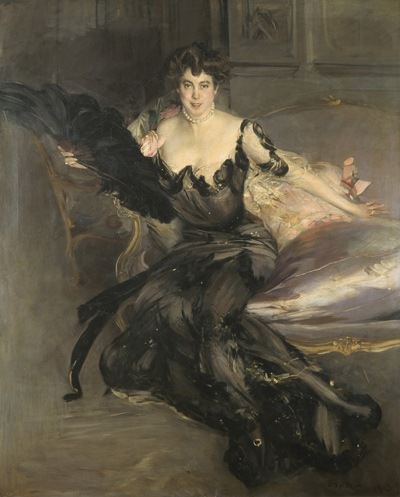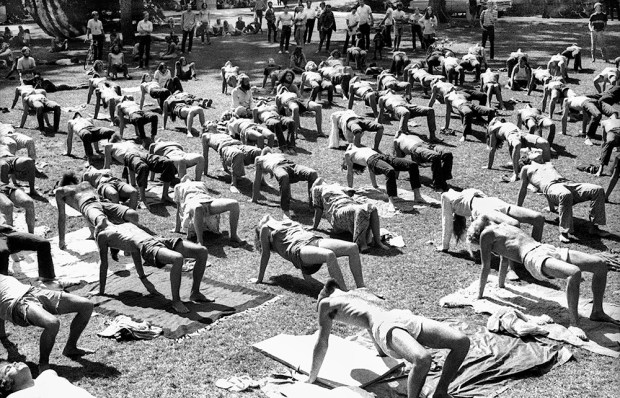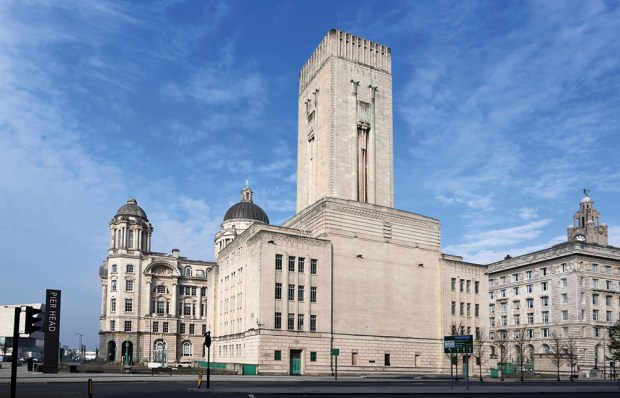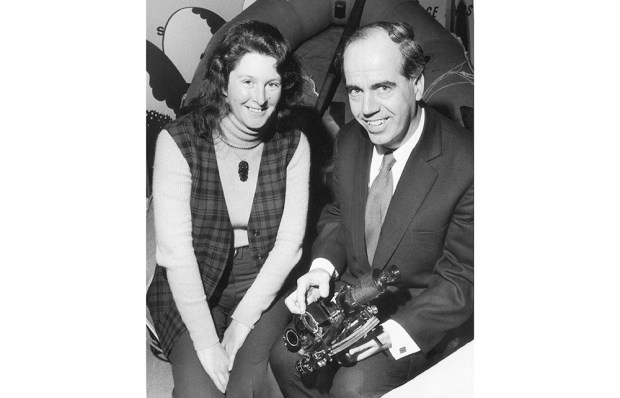She sits there on the cover exuding sex and wealth and a certain knowingness. Mrs Lionel Phillips, who came from a modest background in South Africa, had the good sense to marry one of the ‘Rand Lords’ who made their piles in the new gold and diamond fields. She and her husband bought their way into society in Britain, accumulating houses and furniture and having themselves painted, as in this wonderful portrait, by the fashionable Giovanni Boldini. That of Mr Phillips is more subdued, even sombre. The face, said the Athenaeum, ‘is amazing in its unscrupulous vulgarity’. Well, one might think, the anonymous critic could have taken a look around him. As the stunning illustrations in Edwardian Opulence — of diamond tiaras, fans covered with gold sequins, rubies and diamonds or Fabergé electric bell pushes made out of precious stones — show, Edwardian society did not shrink from showy ostentation, even vulgarity.
This lovely lush book, produced to accompany an exhibition in the spring at the Yale Center for British Art, captures well that flamboyant world of the last decades before the Great War. The illustrations show interiors rich with gold and red, their rooms filled with expensive and elaborate furniture. (The Edwardian rich had a particular passion for objects from the ancien régime.) In one series of photographs the proud owners show off their hand-built motorcars. It is no accident that Thorsten Veblen, at the new University of Chicago, came up with the notion of conspicuous consumption.
What also comes through is power, both of the rich and of Britain itself. John Sargent’s portrait of the ruthless and cynical Sir Frank Swettenham shows a supremely confident man, his arm resting on an elaborate piece of gold cloth which he had collected in Malaya, much as he had collected local states for the empire. Today perhaps he would be a successful hedge-fund manager or entrepreneur in Silicon Valley. The painting by the Dane Neils Møller Lund, entitled ‘The Heart of the Empire’, which shows the City of London from the roof of the Royal Exchange, is a reminder of Britain’s role at the centre of its own empire and of an informal financial one. At the Delhi Durbar of 1903, perhaps the highwater mark of imperial pomp and circumstance, Mary Curzon, the Viceroy’s American wife, wore a Worth design which became internationally famous as ‘The Peacock Gown’. Indian embroiderers worked for months to create a shimmering, glistening image of peacock feathers.
The world, as Mary Curzon herself demonstrated, was also increasingly an international one linked by trade and investment, modern communications, and the movement of peoples. Sargent and James Whistler were both Americans who ended up in Britain. Byam Shaw was born in India. In his extraordinary design for a curtain at the new Coliseum, over a third of the figures depicting the glories of the theatre are foreigners. Harry Lauder stands just in front of Richard Wagner while Ignacy Padrewski is beside Sir Henry Irving.
Society was changing as well. The middle classes were larger and more prosperous while the newly rich were banging on the doors of Edwardian society, doors which they found already half open. Edward VII had shaken the old exclusive aristocratic world by including Jews in his social circle while many of the great landed families had brought in rich American brides whose dowries propped up their dwindling wealth. There were rules to be learned of course, from how to shoot pheasant to what to wear for each occasion. ‘I thought,’ wrote Edward crossly, ‘everyone must know that a short jacket is always worn with a silk hat at a private view in the morning.’ Being presented at court was almost mandatory and one of a series of photographs included here shows woman after woman swathed in yards of fine fabrics and laden with jewels.
Photography, which was still relatively new, helped to capture Edwardian society and it also influenced it in turn. Dress designers and artists such as Sargent, William Orpen and Whistler played with the contrast between black and white. At one of his openings Whistler insisted that women wear only those two shades so that they would not clash with his yellow walls. In Boldini’s portrait of the French actress Ginette Lantelme, almost the only colour comes from her chestnut hair and a dash of her pink rose. There are long forgotten faces here — languid girls and women in a series of early colour photographs — but also familiar ones such as George Bernard Shaw, Herbert Asquith or Vita Sackville-West. Among the many treasures are Frederick Henry Evans’s wonderful photograph of the sea of steps leading to the chapter house at Wells cathedral.
The accompanying essays make much of the notion of ‘self-fashioning’, which seems a slightly portentous way of saying that the socially ambitious Edwardians modelled themselves on those whom they aspired to join. What helped in the process was publicity. The Edwardians had their own cult of celebrity, as an increasingly literate public gobbled up the stories and scandals of the rich and the powerful. The new mass newspapers and magazines such as Queen, Tatler and Country Life made famous the shots who killed thousands of birds or of the great beauties such as Lillie Langtry or Daisy, Princess of Pless, with their tiny waists, artfully piled up hair and dreamy expressions. And growing prosperity, mass production, and the new department stores such as Selfridges now made it possible for the middle classes to copy the styles of the rich.
As the various contributors rightly point out, we should not be lulled into thinking that those Edwardian years were all golden and carefree. At home, working-class militancy was on the increase, the suffragette movement was dividing society and the Irish question was threatening to bring civil war, while abroad national rivalries repeatedly brought Europe to the brink of war. The popular genre of history painting was not merely the last gasp of an exhausted tradition but a way of exploring issues in the Edwardians’ own world. Frank Dicksee’s ‘The Two Crowns’, with its magnificent king looking anxiously at the figure of Christ on the cross, shows the tensions between worldly and spiritual values while John Collier’s ‘problem pictures’ such as ‘The Cheat’ or ‘A Fallen Idol’ depict moral dilemmas.
The very pace of change made many uneasy. What was being lost of value from the past? The Folk Song Society, founded in 1898, tried to preserve the old songs before they vanished. In his cycle Songs of Travel the composer Ralph Vaughan Williams celebrated the sturdy peasant wandering freely about the countryside, while the painter Augustus John played at being a gypsy in a caravan with his wife and mistress. In Old West Surrey Gertrude Jekyll, later to be famous as a garden designer, lamented the disappearance of the old crafts. The Guild of Handicraft, founded 1888, attempted to move labourers from the East End of London to the rural paradise of Chipping Campden so they could become craftsmen in the old style; the locals and newcomers failed to get on and the Guild was dissolved in 1907.
The Edwardian nostalgia, well-illustrated here, for an older world was rather like the passion for organic farming and the slow food movement of today: a longing to return to a simpler world without giving up all the benefits of the modern. Edwardian painters generally showed sunny landscapes with children playing and happy labourers. They had less to say about the miseries of rural poverty.
In 1913 Charles Sims did an idyllic countryside scene of children listening to Clio, goddess of history. When one of his sons was killed the following year in the Great War he went back and painted over her scroll with red. A sense of the coming catastrophe runs through the book; indeed the first essay starts with Orpen’s ‘To the Unknown Soldier in France’.
The Edwardian age, claims the introduction, was ‘a time poised on the brink of destiny, self-consciously aware of a momentousness that would later be sustained by the onset of disastrous events’. There is surely a danger in reading too much back into the period. The Great War was not, I would argue, inevitable but rather the product of human mistakes and decisions. Without it, the Edwardians might have continued on their different ways and a new world been born more gently. It is hard, though, to leaf through these pages and not keep thinking of the doom that was waiting.
Got something to add? Join the discussion and comment below.
Get 10 issues for just $10
Subscribe to The Spectator Australia today for the next 10 magazine issues, plus full online access, for just $10.
Margaret MacMillan’s The War that Ended the Peace will be published in October.
You might disagree with half of it, but you’ll enjoy reading all of it. Try your first month for free, then just $2 a week for the remainder of your first year.














Comments
Don't miss out
Join the conversation with other Spectator Australia readers. Subscribe to leave a comment.
SUBSCRIBEAlready a subscriber? Log in